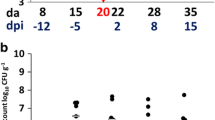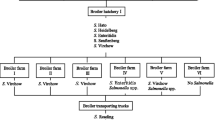Abstract
The prevalence of Campylobacter (>90%) and Salmonella (33%) in turkeys at slaughter has been estimated. This report describes studies to estimate the time of entry of Campylobacter and Salmonella into the brooder house, which is the first stage of commercial turkey production. In trial 1, birds (∼100 per time point) were monitored by conventional culture at three intervals (0, 9, and 16 days of age). Campylobacter spp. were not detected in poults at the day of hatch; Salmonella was isolated from the ceca (3.9%) and yolk sac (0.1%). By day 9, Salmonella were frequently isolated from the ceca (55%) and small intestine (45%) while Campylobacter was not cultured. By day 16, the prevalence of Salmonella in the ceca (21%) and small intestine (5.1%) had declined; Campylobacter was infrequently isolated from either the ceca (2%) or small intestine (3%). In trial 2, poults (50 per time point at 5, 20, and 33 days of age) were monitored for Campylobacter and Salmonella by real-time polymerase chain reaction (PCR); Salmonella was also monitored by conventional culture. Whereas Campylobacter was not detected by real-time PCR in the ceca of 5-day-old birds, it was detected on days 20 (92%) and 33 (90%). In contrast, Salmonella was isolated from young birds at days 5 (98%), 20 (98%), and 33 (98%), after which time the turkeys were moved to the finisher house. At slaughter at 138 days, Salmonella prevalence in the ceca had declined (4.5%) in contrast to the prevalence of Campylobacter (92%). Antimicrobial sensitivity profiles of the Salmonella isolates indicated an increase of sulfonamide-resistant isolates throughout the brooder stage. Genotyping by pulsed-field gel electrophoresis analysis of Salmonella (45 isolates per sampling time) indicated fluctuating populations as the birds matured.

Similar content being viewed by others

References
Ailes, E., Demma, L., Hurd, S., Hatch, J., Jones, T. F., Vugia, D., et al. (2008). Continued decline in the incidence of Campylobacter infections, FoodNet 1996–2006. Foodborne Pathogens and Diseases, 5(3), 329–337. doi:10.1089/fpd.2008.0090.
Buzby, J. C., & Roberts, T. (1997). Economic costs and trade impacts of microbial foodborne illness. World Health Statistics Quarterly, 50, 57–66.
Callicott, K. A., Friethriksdottir, V., Reiersen, J., Lowman, R., Bisaillon, J. R., Gunnarsson, E., et al. (2006). Lack of evidence for vertical transmission of Campylobacter spp. in chickens. Applied and Environmental Microbiology, 72(9), 5794–5798. doi:10.1128/AEM.02991-05.
Centers for Disease Control and Prevention. (2006). Preliminary FoodNet data on the incidence of infection with pathogens transmitted commonly through food—10 states, United States, 2005. Morbidity and Mortality Weekly Report, 55(14), 392–395. http://www.cdc.gov/mmwr/preview/mmwrhtml/mm5514a2.htm. Accessed 14 April 2006.
Guo, L., Killefer, J., Kenney, P. B., & Amick-Morris, J. D. (1999). Use of arbitrarily primed polymerase chain reaction to study Salmonella ecology in a turkey production environment. Poultry Science, 78(1), 24–31.
Hafez, H. M., & Jodas, S. (2000). Salmonella infections in turkeys. In C. Wray, & A. Wray (Eds.), Salmonella in domestic animals (pp. 133–156). New York, USA: CABI Publishing.
Havelaar, A. H., Mangen, M. J., de Koeijer, A. A., Bogaardt, M., Everes, E. G., Jacobs-Reitsma, W. F., et al. (2007). Effectiveness and efficiency of controlling Campylobacter on broiler chicken meat. Risk Analysis, 27(4), 831–844. doi:10.1111/j.1539-6924.2007.00926.x.
Heyndrickx, M., Vandekerchove, D., Herman, L., Rollier, I., Grijspeerdt, K., & de Zutter, L. (2002). Routes for salmonella contamination of poultry meat: epidemiological study from hatchery to slaughterhouse. Epidemiology and Infection, 129(2), 253–265.
Hoffman, S., Fischbeck, P., Krupnick, A., & McWilliam, M. (2007). Using expert elicitation to link foodborne illnesses in the United States to foods. Journal of Food Protection, 70(5), 1220–1229.
Hoover, N. J., Kenney, P. B., Amick, J. D., & Hypes, W. A. (1997). Preharvest sources of Salmonella colonization in turkey production. Poultry Science, 76(9), 1232–1238.
Humphrey, T., O’Brien, S., & Madsen, M. (2007). Campylobacters as zoonotic pathogens: a food production perspective. International Journal of Food Microbiology, 117(3), 237–257. doi:10.1016/j.ijfoodmicro.2007.01.006.
Hunter, S. B., Vauterin, P., Lambert-Fair, M. A., Van Duyne, M. S., Kubota, K., Graves, L., et al. (2005). Establishment of a universal size standard strain for use with the PulseNet standardized pulsed-field gel electrophoresis protocols: converting the national databases to the new size standard. Journal of Clinical Microbiology, 43(3), 1045–1050. doi:10.1128/JCM.43.3.1045-1050.2005.
Idris, U., Lum, H. J., Maier, M., Sanchez, S., Hofacre, C. L., Harmon, B. G., et al. (2006). Dissemination of fluoroquinolone-resistant Campylobacter spp, within an integrated commercial poultry production system. Applied and Environmental Microbiology, 72(5), 3441–3447. doi:10.1128/AEM.72.5.3441-3447.2006.
Jones, T. F., Scallan, E., & Angulo, F. J. (2007). FoodNet: overview of a decade of achievement. Foodborne Pathogens and Diseases, 4(1), 60–66. doi:10.1089/fpd.2006.63.
Kim, A., Lee, Y. J., Kang, M. S., Kwag, S. I., & Cho, J. K. (2007). Dissemination and tracking of Salmonella spp. in integrated broiler operation. Journal of Veterinary and Animal Sciences, 8(2), 155–161.
Kubota, K., Barrett, T. J., Ackers, M. L., Bachman, P. S., & Mintz, E. D. (2005). Analysis of Salmonella enterica serotype Typhi pulsed-field gel electrophoresis patterns associated with international travel. Journal of Clinical Microbiology, 43(3), 1205–1209. doi:10.1128/JCM.43.3.1205-1209.2005.
Liljebjelke, K. A., Hofacre, C. L., Liu, T., White, D. G., Ayers, S., Young, S., et al. (2005). Vertical and horizontal transmission of salmonella within integrated broiler production system. Foodborne Pathogens and Diseases, 2(1), 90–102. doi:10.1089/fpd.2005.2.90.
Line, J., Hiett, K., & Conlan, A. (2008). Comparison of challenge models for determining the colonization dose of Campylobacter jejuni in broiler chicks. Poultry Science, 87, 1700–1706. doi:10.3382/ps.2008-00027.
Magurran, A. E. (1988). Ecological diversity and its measurement. Princeton, New Jersey: Princeton University Press.
Matagaras, M., Skandamis, P. N., & Drosinos, E. H. (2008). Risk profiles of pork and poultry meat and risk ratings of various pathogen/product combinations. International Journal of Food Microbiology, 126(1–2), 1–12. doi:10.1016/j.ijfoodmicro.2008.05.014.
McCapes, R. H., Osburn, B., & Riemann, V. (1991). Safety of foods of animal origin: model for elimination of Salmonella contamination of turkey meat. Journal of the American Veterinary Medical Association, 199(5), 875–880.
Mead, P. S., Slutsker, L., Dietz, V., McCaig, L. F., Breesee, J. S., Shapiro, C., et al. (1999). Food-related illness and death in the United States. Emerging Infectious Diseases, 5(5), 607–625.
Miller, W. G., & Mandrell, R. E. (2005). Prevalence of Campylobacter in the food and water supply: incidence, outbreaks, isolation, and detection. In J. Ketley, & M. E. Konkel (Eds.), Campylobacter: molecular and cellular biology (pp. 101–163). Norfolk, UK: Horizon Bioscience.
Muraoka, W., Gay, C., Knowles, D., & Boruck, M. (2003). Prevalence of Listeria monocytogenes subtypes in bulk milk of the Pacific Northwest. Journal of Food Protection, 66(8), 1413–1419.
National Committee for Clinical Laboratory Standards (NCCLS). (2001). Performance Standard for Antimicrobial Susceptibility Testing. Approved standard M100-S11. Wayne, PA.
Naugle, A. L., Barlow, K. E., Eblen, D. R., Teter, V., & Umholtz, R. (2006). US Food Safety and Inspection Service testing for Salmonella in selected raw meat and poultry products in the United States, 1998 through 2003: analysis of set results. Journal of Food Protection, 69(11), 2607–2614.
Nayak, R., & Stewart, T. (2008). Molecular epidemiological analysis and microbial source tracking of Salmonella enterica serovars in a preharvest turkey production environment. Foodborne Pathogens and Diseases, 5(2), 115–126. doi:10.1089/fpd.2007.0029.
Nayak, R., Stewart, T., Wang, R. F., Lin, J., Cerniglia, C. E., & Kenney, P. B. (2004). Genetic diversity and virulence gene determinants of antibiotic-resistant Salmonella isolated from preharvest turkey production sources. International Journal of Food Microbiology, 91(1), 51–62. doi:10.1016/S0168-1605(03)00330-1.
Pearson, A. D., Greenwood, M., Kevin, R., Feltham, A., Healing, T. D., Donaldson, J., et al. (1996). Microbial ecology of Campylobacter jejuni in a United Kingdom chicken supply chain: intermittent common source, vertical transmission, and amplification by flock propagation. Applied and Environmental Microbiology, 62(12), 4614–4620.
Ribot, E. M., Fair, M. A., Gautom, R., Cameron, D. N., Hunter, S. B., Swaminathan, B., et al. (2006). Standardization of pulsed-field gel electrophoresis protocols for the subtyping of Escherichia coli O157:H7, Salmonella and Shigella for PulseNet. Foodborne Pathogens and Diseases, 3(1), 59–67. doi:10.1089/fpd.2006.3.59.
Rostagno, M. H., Wesley, I. V., Trampel, D. W., & Hurd, H. S. (2006). Salmonella prevalence in market-age turkeys on farm and at slaughter. Poultry Science, 85(10), 1838–1842.
Sahin, O., Luo, N., Huang, S., & Zhang, Q. (2003). Effect of Campylobacter-specific maternal antibodies on Campylobacter jejuni colonization in young chickens. Applied and Environmental Microbiology, 69(9), 5372–5379. doi:10.1128/AEM.69.9.5372-5379.2003.
Sandrou, D. K., & Arvanitoyannis, I. S. (1999). The implementation of hazard analysis critical control point in the meat and poultry industry. Food Reviews International, 15(3), 265–308.
Scallan, E. (2007). Activities, achievements and lessons learned during the first 10 years of the Foodborne Diseases Active Surveillance Network: 1996–2005. Clinical Infectious Diseases, 44(5), 718–725. doi:10.1086/511648.
Shane, N. S. M., & Stern, N. J. (2003). Campylobacter infection. In Y. M. Saif (Ed.), Diseases of poultry (pp. 615–630). Ames, IA: Iowa State Press.
Sheppard, S. K., McCarthy, N. D., Falush, D., & Maiden, M. V. C. (2008). Convergence of Campylobacter species; implications for bacterial evolution. Science, 320(5873), 237–239. doi:10.1126/science.1155532.
Stern, N. J., & Robach, M. C. (2003). Enumeration of Campylobacter spp in broiler feces and in corresponding processed carcasses. Journal of Food Protection, 66(9), 1557–1563.
Stern, N. J., Bailey, J. S., Meinersmann, R. J., Cox, N. A., & Blankenship, L. C. (1991). Simultaneous colonization of Campylobacter jejuni and Salmonella typhimurium in day-old chicks. Poultry Science, 70(4), 790–795.
Stern, N. J., Wojton, B., & Kwiatek, K. (1992). A differential-selective medium and dry ice-generated atmosphere for recovery of Campylobacter jejuni. Journal of Food Protection, 55(7), 514–517.
Tran, T. T. (1998). A blood-free enrichment medium for growing Campylobacter spp. under aerobic conditions. Letters in Applied Microbiology, 26(2), 145–148. doi:10.1046/j.1472-765X.1998.00295.x.
Wallace, J. S., Stanley, K. N., & Jones, K. (1998). The colonization of turkeys by thermophilic campylobacters. Journal of Applied Microbiology, 85(2), 224–230. doi:10.1046/j.1365-2672.1998.00470.x.
Wesley, I. V., Hurd, H. S., Muraoka, W. T., Harbaugh, E., & Trampel, D. (2005a). The effect of transport and holding on Salmonella and Campylobacter. World Politics, 21(9), 28–30.
Wesley, I. V., Muraoka, W. T., Trampel, D., & Hurd, H. S. (2005b). The effect of perimarketing events on the prevalence of Campylobacter jejuni and Campylobacter coli in market-weight turkeys. Applied and Environmental Microbiology, 71(6), 2824–2831. doi:10.1128/AEM.71.6.2824-2831.2005.
Wesley, I. V., Harbaugh, E., Trampel, D. W., Rivera, F., & Hurd, H. S. (2006). The effect of perimarketing events on the prevalence of Salmonella in market weight turkeys. Journal of Food Protection, 69(8), 1785–1793.
Acknowledgements
We acknowledge the technical expertise of Ms. Rachel Pinney and Ms. Roxanne Taylor for conducting the real-time PCR analyses. We are indebted to the turkey producers for access to their brooder flocks and to their birds at slaughter. We thank Jan Eifling for the literature search and Linda Miller for the secretarial assistance. We are grateful to Mr. Timothy Klinefelter, Iowa State University Veterinary Diagnostic Laboratory, for providing the 2007 avian Salmonella antibiograms. We acknowledge the critical comments of Drs. Thomas Casey, S. Bhaduri, and R. Kunkle, which improved this manuscript.
Author information
Authors and Affiliations
Corresponding author
Additional information
Mention of trade names or commercial products in this publication is solely for the purpose of providing specific information and does not imply recommendation or endorsement by the United States Department of Agriculture.
Rights and permissions
About this article
Cite this article
Wesley, I.V., Muraoka, W.T. Time of Entry of Salmonella and Campylobacter into the Turkey Brooder House. Food Bioprocess Technol 4, 616–623 (2011). https://doi.org/10.1007/s11947-009-0190-2
Received:
Accepted:
Published:
Issue Date:
DOI: https://doi.org/10.1007/s11947-009-0190-2



